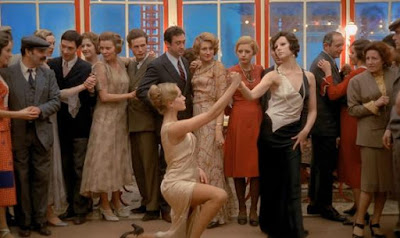Are you willing to step out of your comfort zone, to embrace in beliefs that may be contentious to others? Are you feeling desperate just to fit into the picture? Are you aiming for a form of flatness in life, which is not subject to any form of perturbations? These appear to be confrontational questions, yet they were exactly the questions Bernardo Bertolucci wanted his audience to think about in one of his most famous films – ‘The Conformist’ (1970)!
‘The Conformist’ was the film that has led Bertolucci to
international stardom as a filmmaker in the early 1970s. Having won a number of
awards around the world and an Oscar nomination for Best Screenplay, the film is
memorable for being one of the most visually brilliant films in the history of
cinema. I can say that is already pleasant by simply looking at the film images
alone – the vibrant images constitute an organic unity of visual poetry that
prove to be rare in cinema. Other than Bertolucci’s genius, the effort and
creativity offered by the director of photography, Vittorio Storaro, was also
essential for bringing ‘The Conformist’ to such a status. In fact, ‘The
Conformist’ could be considered one of Storaro’s most iconic works, and Storaro
is the rare sort of cinematographer that has its own photographic style, which
I will discuss in the later passages of this article. No matter which filmmaker
he has worked with, you can likely detect his presence through his signature
style. Again, ‘The Conformist’ is a beautiful film one can easily fall in love
with – and what is the problem if that is a really great one?
The story concerned Marcello, who lived in the Fascist era of
When one watches ‘The Conformist’, how can one not notice
the stunning visual aspect of the film? While Bertolucci has been largely
responsible for delivering such an impressive mise-en-scene, the achievement
would not be possible without the hard work and vision of Vittorio Storaro, the
director of photography who has collaborated on numerous occasions with
Bertolucci. Storaro can be considered as the rare sort of cinrmatographer who
has developed a unique and recognizable visual style as original as any
filmmakers. Indeed, ‘The Conformist’ can be seen as one of Stararo’s major
achievements, and the film can serve as a textbook example of how to do brilliant
cinematography.
Storaro’s camera style has a few notable characteristics.
First, that is the fluid and mobile camera movement, and that is so smooth that
it appears as if the camera is dancing, and that gives the audience a flowing
and liberating feel. He is also known for a narrative use of lighting effect,
and often uses high contrast lighting effect to enhance the atompshere. His
choice of colour and light usually led to expressive effects that contributed
to the narrative and atmosphere of the scene. Storaro was particularly noted
for a combination of colour tune consisting of cold blue/warm yellow, giving
very contrasting and expressive results. Having a sound understanding of colour
temperature, he has been able to make a number of beautitul Technicolor films
with directors including Bertolucci.
Bertolucci and Storaro have drawn influenced from the
artistic style most associated with Fascist Italy, in order to lead the
audience into that particular political climate in the 1930s. Notice that the
preferences were not merely visual gimmicks. The visual and camera or lighting
style also served a narrative purpose. It illustrated the exaggerated situation
of Marcello and the Fascist beliefs he attempted to embrace and conform to,
much like the decors of Expressionism were used to externalize the madness of
someone’s mind.
The film has a unique style of having contrasting light and
dark/shadow often in the same shot, rather than a balanced or natural
arrangement. This style was deliberate from the filmmakers likely because they
tried to show the co-existence of conflicting ideologies, and most of all, good
and evil that fought for control in the world.
The filmmakers have used light and dark to represent the
Freudian conscious and unconscious respectively. They have decided to shoot the
Italian scenes in a more claustrophobic way, and the color tone was dry and
institutional, to show Marcello’s entrapment in the Fascist regime. In
contrast, the French scenes were more balanced with light and dark, and the space
was more open, as if offering Marcello an opportunity to escape – which of
course he failed to grasp.
Before we finish here, I also want to divert a bit from ‘The
Conformist’ and talk about Storaro’s impressive work in 2 other films, ‘Last
Tango in Paris
(1/2)
by Ed Law
Film Analysis









